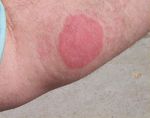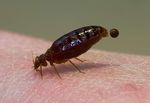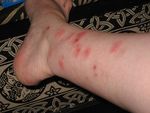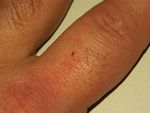BED BUGS - What you need to know
←
→
Page content transcription
If your browser does not render page correctly, please read the page content below
By the end of this session, participants will: • Understand the biology, risk and epidemiology of bed bugs; • Learn how to determine when bed bug infestations are present; • Understand the prevention and control of bed bug infestations; • Acquire the knowledge and expertise to respond effectively to various clinical scenarios involving bed bugs.
Overview of what patients are told: • Reports of bed bugs in Ontario and across Canada are on the rise. • It’s important to know the facts. • Anyone, anywhere can get bed bugs. • But…they can be prevented and controlled.
Naming History • Ancient Rome, bed bugs were called Cimex (meaning “bug”), while the species designation lectularius referred to a bed or couch. • Early Greek term for bed bug was Coris, meaning “to bite,” from which the word coriander comes. Coriander (cilantro) is one of the world’s oldest spices. • England, bed bugs were simply referred to as “Bugs”. • Early Spanish word for bed bug — “chinche” is especially relevant today since Spanish-speaking customers often refer to bed bugs as chinches or chinche de cama — bug of the bed. • Other names used include wall louse, bed louse, wallpaper flounder, night riders, red coats and crimson ramblers. • Bed bugs did not occur in North America before the arrival of European settlers, thus there is no word for them in the language of Native Americans.
Family Cimicidae ~ 91 species – bat hosts – 13 genera, 61 species – bird hosts (swallows and swifts) - 26 species – mammals and birds – 2 species – hosts unknown – 2 species
Quick Facts… • The human bed bug (Cimex lectularius) and its relatives (Cimicidae) form a small group of bloodsucking Insects. • It has never been demonstrated that bed bugs transmit any human disease (including Hep A and HIV/AIDS). • Because of the different habits of the various bed bugs, proper identification determines where to direct controls to be most effective. • The bite of these bugs often is painless, but a toxic saliva injected during feeding will later cause severe itching and an inflamed welt. However, individuals may vary widely in sensitivity to these bites. Often, a series of two to three welts are produced in close proximity following feeding by bed bugs. Pictures to follow… • Bed bugs have a short broad head, broadly attached to the prothorax, and an oval body.
Medical Importance
• Naturally infected with >41 human pathogens
• Never proven to transmit any human disease
• Several species feed on humans
Common & Tropical Bed Bugs, Bat Bugs & “Bird” Bugs
• Salivary proteins cause “sensitivity” to repeated
bites by large numbers of bed bugs
• Serious social stigma to “having” an infestation
• Secondary infectionBiology
Life Cycle
– Females can lay ~200-500 eggs
– Eggs hatch in 1-2 weeks
– Nymphs start to feed immediately
– Nymphal stage is 14-30 days
– Entire life cycle is 4-9 weeks
– Adults can survive, conditions
dependent, up to 12-18 months,
or longer, without feeding
– May migrate if it ‘senses’ a
potential food source
.
© Orkin IncLifecycle
Eggs
1st Instar
1st Instar
Feeding
Longevity (mean in days) in Once-fed Bed Bugs (70-75%RH) (Omori, 1941) Stage 10C 18C 27C 37C Instar 1 275 114 28 17 Instar 2 399 171 46 30 Instar 3 413 214 71 35 Instar 4 433 235 73 37 Instar 5 485 161 40 33 Female 425 277 87 32 Male 402 176 43 29
Feeding • Adults/Nymphs feed ‘usually’ at night • Nymphs – 3 min average 1st instar; Adults – 10 to 15 min • Saliva causes the allergic reaction • Digest blood meal; molts and feeds again when its ready or ‘wait’ until host present • They do not stay on the host longer than it takes to get a blood meal • “Bites” – usually in two to three spatially close welts
WHAT CAN YOU DO?
Identify Worried you may have bed bugs? Get a hair dryer (set on hot), a vacuum, thin knife or credit card, and search their favourite hiding spots: – Mattresses – Box spring/bed frame – Cracks/crevices on or near bed – Bedroom baseboards – Nightstands – In or near clutter
Fecal Matter/Blood Spots
M Potter,
2004Bedbug Evidence
M Potter,
2004M Potter, 2004
CLINICAL DIAGNOSIS
Characteristic ‘Immediate’ Reaction
Delayed Reaction (>24 hours)
Bedbug Prevention • Be wary of acquiring secondhand beds, bedding, clothing, books, electronics and furniture, anything that can carry a bed bug on/in it • Vacuum suitcases after returning from a vacation (put in freezer to slow them down then into hot dryer) • Repair cracks in plaster and glue down loosened wallpaper • Remove and destroy wild animal roosts and bird nests when possible (Bat Bugs) • Check furniture, bedding or normal sleeping areas regularly • Clean and vacuum regularly as per normal home sanitation measures
Take Action If you find bed bugs in your home, don’t wait – take action: • Tell your landlord or building maintenance person at once. • Don’t try to do it yourself. Insect foggers will not get rid of bed bugs. • To control bed bugs you will need a licensed professional pest control operator with bed bug experience.
Take Action
What you need to do before the pest control operator arrives:
• Wash all bedding in hot water or dry clean. Place pillows in the dryer on
high heat for a minimum of 30 minutes.
• Steam clean, wet vacuum or shampoo carpeting and furnishings.
• Vacuum mattresses, bed frames, baseboards and objects close to the
bed. Discard the vacuum bag in a tightly sealed garbage bag before
disposal.
• Empty all dressers and closets - including linen closets. Clean articles
should be placed in the dryer on high heat for a minimum of 30 minutes.
• All soiled articles need to be washed in hot water and dried on high
heat.
• Remove all clutter, such as: books, magazines, toys and home
accessories. Clutter is home to bed bugs. Place all items in tightly sealed
garbage bags and leave them in the room to be treated.Control of Bedbugs
Non-chemical control (not an all inclusive list)
– Sticky Traps/Double-sided tape
– Mattress covers – Allerzip, Gardex; Bed posts in BB Cans/traps
– Heat clothes in dryer for 15-20 min.; will kill all stages (>120°F)
– Hot steam along baseboards, wallpaper etc.
– Vacuum often with strong suction
– Use a scrub brush along the seams of mattresses
– Heat (> 130°F/55°C) (put in heat box, rooms, buildings etc)
– Expose bugs to cold temperatures below 32°F/0°C
Generally Does Not Work : Chilling period must be maintained for
many days (adults) greater than -20°C; colder than most freezers
• Eggs - NOT a control option
• Overall, it is NOT an effective control option and is not
recommendedControl of Bedbugs
• Chemical control
– Various aerosol sprays, liquids, and dust products are
available
– Permethrin (Prelude/Dragnet), Cyfluthrin (Tempo),
Bendiocarb (Ficam), and Diatomaceous earth
– Linens and mattresses should not be sprayed unless
products are registered/labeled for this useWhy they are a control challenge? 1. Often hard to detect in small numbers (small, generally nocturnal, cryptic, & fairly mobile). 2. No reliable attractant available (currently). 3. Readily detect (& avoid) many chemicals. 4. Adults can live > 1 yr. without feeding. [Nymphs fed > once can live > 3 mo. w/o feeding]. 5. Insecticide resistance newly documented. 6. Very easily re-introduced and/or spread.
Challenges to Effective Control • Hoarding Issues • Laundry • Lack of client co-operation due to cost, mistrust of technician, lack of education • Room not properly prepared for treatment • Client embarrassed does not tell anyone with an active infestation or re-introduction
The Social Impacts of an Infestation
Dr. Elizabeth Comack
Department of Sociology
University of ManitobaMore than just itchy bites • Loss of belongings • Health problems exacerbated • Insecticide exposure • Social Stigma • Social Isolation • Negative impact on identity
MYTHS
Myth #1 Throwing out my bed will get rid of bed bugs FACT. Bed bugs can occupy almost any dark crack or crevice in a room. Almost everything including clothing, bedding, furniture and electronics can be treated to remove bed bugs.
Myth #2 Bed bugs are only found in low-income neighborhoods. FACT. Bed bugs happen to anyone, anywhere. You get bed bugs simply by coming into contact with them.
Myth #3 Bed bugs cannot survive in Canada due to cold winters. FACT. Even with our cold winters bed bugs continue to survive in all parts of Canada. Bed bugs can be found in almost every country and region. They are a global pest.
Myth #4 I don’t travel very much, so I’m safe. FACT. Travel, whether overseas or in Canada, is not the only possible source of bed bugs. Situations such as riding public transit, having a houseguest or purchasing a piece of second- hand furniture can offer bed bugs a free ride into your home.
Myth #5 My partner seems to have signs of bites, but I do not – so we don’t have bed bugs. FACT. Two people sleeping in the same bed may both be bitten by bed bugs but react in a different way. Some people immediately have a reaction to the bites while others show little or no sign.
Myth #6 There are over-the-counter treatments available for bed bugs. FACT. Such remedies are considered to be ineffective and some are fire hazards. The best way to get rid of bed bugs is to hire a licensed pest control expert and follow their instructions.
Myth #7 I have a metal bed, so I have nothing to worry about. FACT. Although metal beds are less hospitable to bed bugs, simply replacing all beds with metal ones will not solve a bed bug problem. In some cases, metal beds may cause bed bugs to hide in less obvious areas of the bed, making the matter worse.
TENANTS
Information for Tenants
• If you find bed bugs, here is what you should do:
– Tenants: Immediately inform your landlord, superintendent, or
property manager.
– Landlords are responsible for maintaining the unit so it is fit for
habitation, and complies with health standards.
– If landlord fails to act, a tenant may make a complaint to the
municipality.
– You are responsible for cooperating with efforts to control bed
bugs.Tenants
• What you should know:
– Landlords have right to enter to inspect and maintain rental units
(written notice, 24 hours in advance).
– Landlords are responsible for the cost. Only licensed pest control
companies should be used.
– You will need to prepare (eliminate clutter, clean your belongings,
moving furniture, etc.).Naming and Framing the Problem:
Bed Bugs are Serious Threat to Public Health
Encountering Bed Bugs
Social and
Economic
Social stigma, Social Marginalization
isolation, Stress (lack of resources
and control over
living conditions)
Compromised HealthFor More Information
• To learn more about bed bugs, and what you can do to
prevent, identify and treat them, visit:
– www.bedbugsinfo.ca
– Contact your local public health unit – visit:
http://www.health.gov.on.ca/english/public/contact/phu/phuloc
_mn.htmlYou can also read



























































